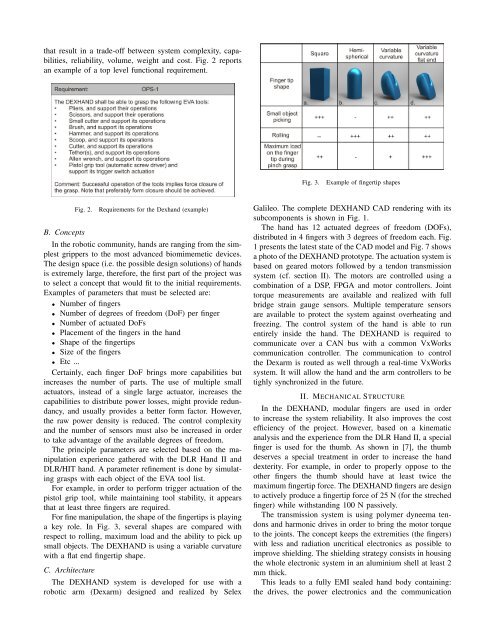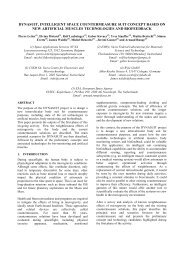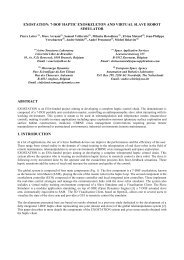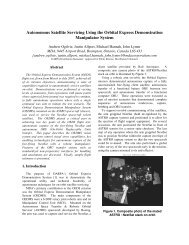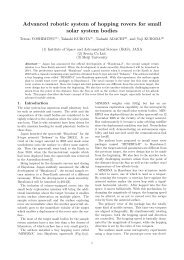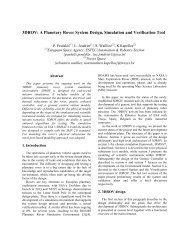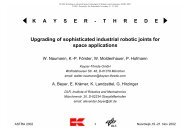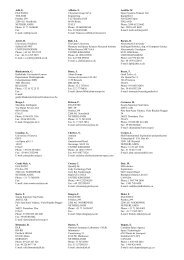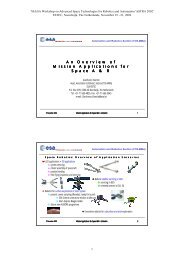Presentatio - ESA - Robotics
Presentatio - ESA - Robotics
Presentatio - ESA - Robotics
Create successful ePaper yourself
Turn your PDF publications into a flip-book with our unique Google optimized e-Paper software.
that result in a trade-off between system complexity, capabilities,<br />
reliability, volume, weight and cost. Fig. 2 reports<br />
an example of a top level functional requirement.<br />
B. Concepts<br />
Fig. 2. Requirements for the Dexhand (example)<br />
In the robotic community, hands are ranging from the simplest<br />
grippers to the most advanced biomimemetic devices.<br />
The design space (i.e. the possible design solutions) of hands<br />
is extremely large, therefore, the first part of the project was<br />
to select a concept that would fit to the initial requirements.<br />
Examples of parameters that must be selected are:<br />
• Number of fingers<br />
• Number of degrees of freedom (DoF) per finger<br />
• Number of actuated DoFs<br />
• Placement of the fingers in the hand<br />
• Shape of the fingertips<br />
• Size of the fingers<br />
• Etc ...<br />
Certainly, each finger DoF brings more capabilities but<br />
increases the number of parts. The use of multiple small<br />
actuators, instead of a single large actuator, increases the<br />
capabilities to distribute power losses, might provide redundancy,<br />
and usually provides a better form factor. However,<br />
the raw power density is reduced. The control complexity<br />
and the number of sensors must also be increased in order<br />
to take advantage of the available degrees of freedom.<br />
The principle parameters are selected based on the manipulation<br />
experience gathered with the DLR Hand II and<br />
DLR/HIT hand. A parameter refinement is done by simulating<br />
grasps with each object of the EVA tool list.<br />
For example, in order to perform trigger actuation of the<br />
pistol grip tool, while maintaining tool stability, it appears<br />
that at least three fingers are required.<br />
For fine manipulation, the shape of the fingertips is playing<br />
a key role. In Fig. 3, several shapes are compared with<br />
respect to rolling, maximum load and the ability to pick up<br />
small objects. The DEXHAND is using a variable curvature<br />
with a flat end fingertip shape.<br />
C. Architecture<br />
The DEXHAND system is developed for use with a<br />
robotic arm (Dexarm) designed and realized by Selex<br />
Fig. 3. Example of fingertip shapes<br />
Galileo. The complete DEXHAND CAD rendering with its<br />
subcomponents is shown in Fig. 1.<br />
The hand has 12 actuated degrees of freedom (DOFs),<br />
distributed in 4 fingers with 3 degrees of freedom each. Fig.<br />
1 presents the latest state of the CAD model and Fig. 7 shows<br />
a photo of the DEXHAND prototype. The actuation system is<br />
based on geared motors followed by a tendon transmission<br />
system (cf. section II). The motors are controlled using a<br />
combination of a DSP, FPGA and motor controllers. Joint<br />
torque measurements are available and realized with full<br />
bridge strain gauge sensors. Multiple temperature sensors<br />
are available to protect the system against overheating and<br />
freezing. The control system of the hand is able to run<br />
entirely inside the hand. The DEXHAND is required to<br />
communicate over a CAN bus with a common VxWorks<br />
communication controller. The communication to control<br />
the Dexarm is routed as well through a real-time VxWorks<br />
system. It will allow the hand and the arm controllers to be<br />
tighly synchronized in the future.<br />
II. MECHANICAL STRUCTURE<br />
In the DEXHAND, modular fingers are used in order<br />
to increase the system reliability. It also improves the cost<br />
efficiency of the project. However, based on a kinematic<br />
analysis and the experience from the DLR Hand II, a special<br />
finger is used for the thumb. As shown in [7], the thumb<br />
deserves a special treatment in order to increase the hand<br />
dexterity. For example, in order to properly oppose to the<br />
other fingers the thumb should have at least twice the<br />
maximum fingertip force. The DEXHAND fingers are design<br />
to actively produce a fingertip force of 25 N (for the streched<br />
finger) while withstanding 100 N passively.<br />
The transmission system is using polymer dyneema tendons<br />
and harmonic drives in order to bring the motor torque<br />
to the joints. The concept keeps the extremities (the fingers)<br />
with less and radiation uncritical electronics as possible to<br />
improve shielding. The shielding strategy consists in housing<br />
the whole electronic system in an aluminium shell at least 2<br />
mm thick.<br />
This leads to a fully EMI sealed hand body containing:<br />
the drives, the power electronics and the communication


